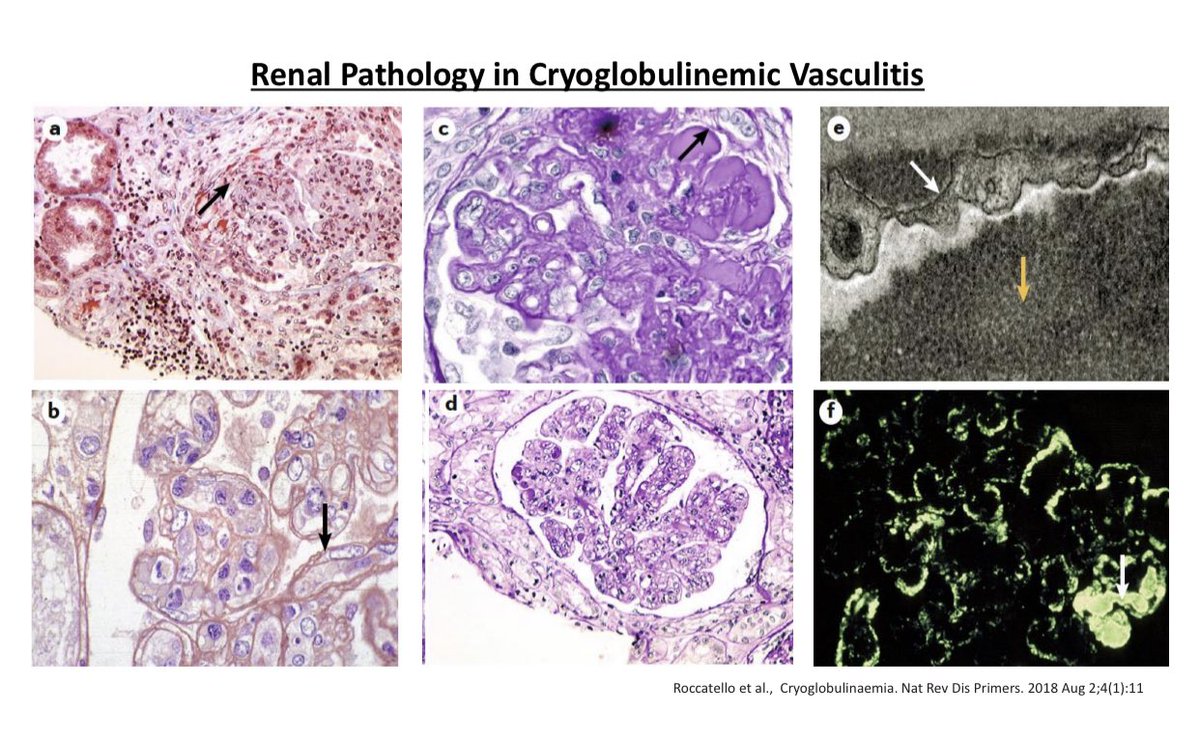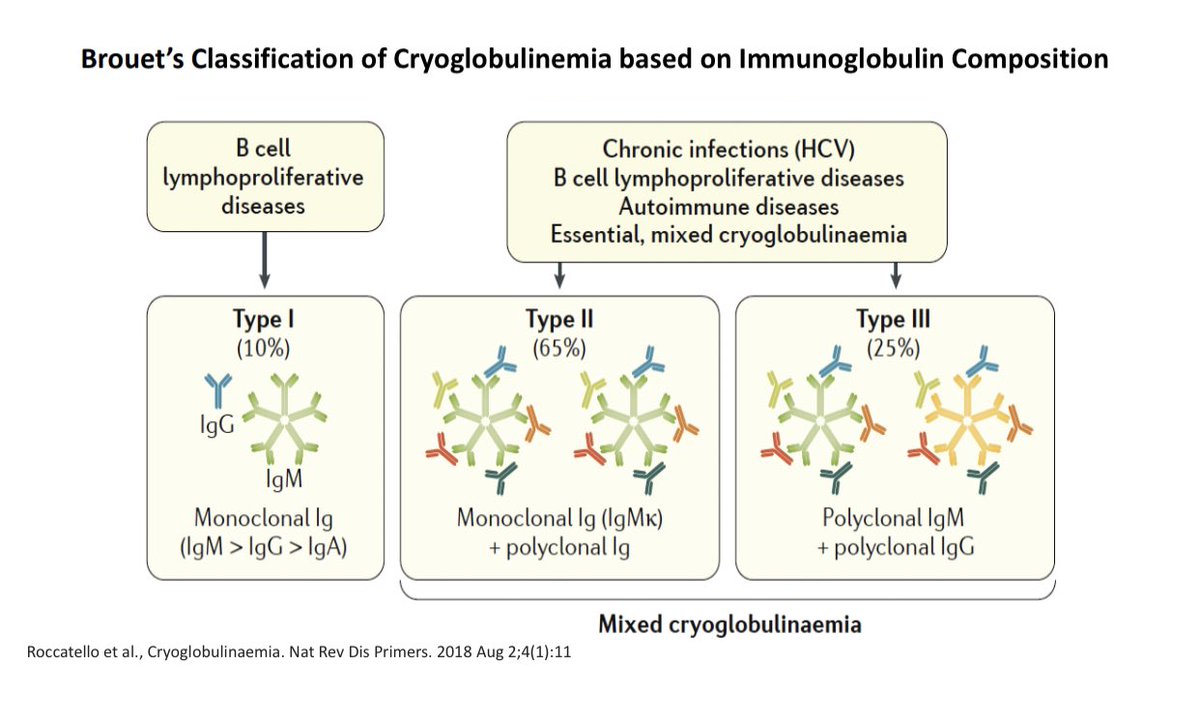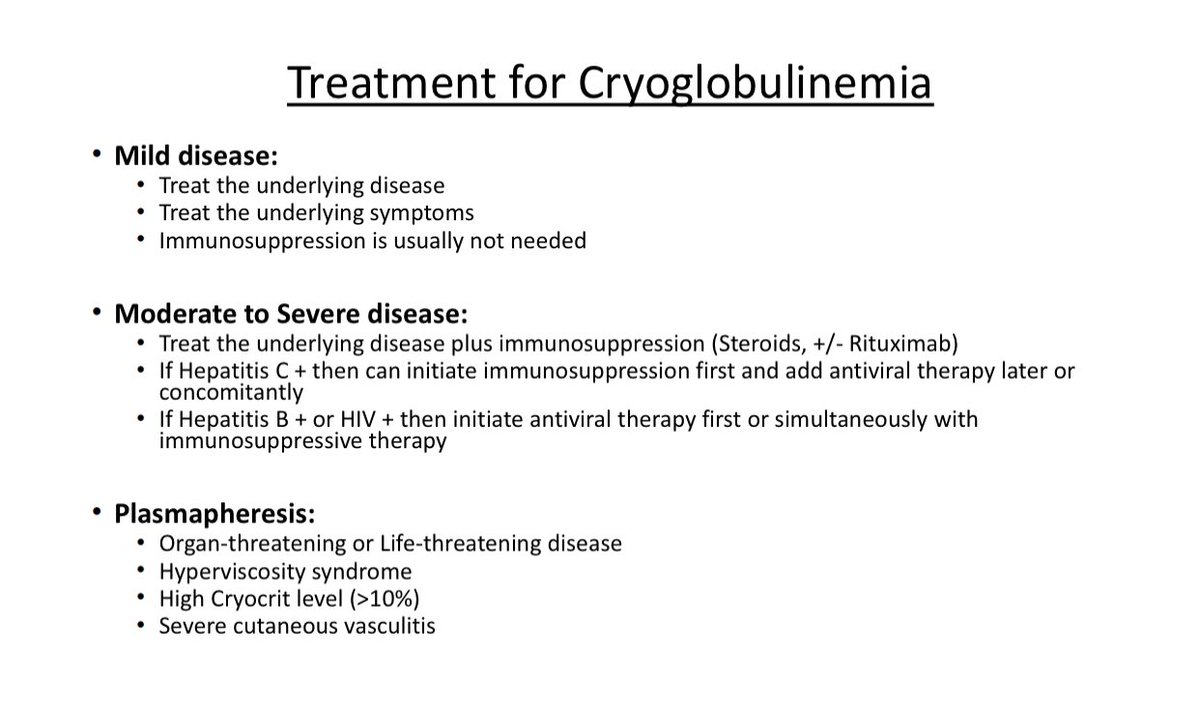
💥 Tweetorial on ‘Cryoglobulinemia’
⚡️What are Cryoglobulins?
⚡️When should a clinician suspect Cryoglobulinemia & Cryoglobulinemia vasculitis?
⚡️How to establish the diagnosis?
⚡️Significance of Rheumatoid Factor
1/
@GlomCon
#Onconephrology
⚡️What are Cryoglobulins?
⚡️When should a clinician suspect Cryoglobulinemia & Cryoglobulinemia vasculitis?
⚡️How to establish the diagnosis?
⚡️Significance of Rheumatoid Factor
1/
@GlomCon
#Onconephrology
⚡️Cryoglobulins are immunoglobulins that reversibly precipitate in the serum at <37 degree C & re-dissolve at >37 degree C
⚡️The fundamental mechanism behind Cryoglobulin formation is aberrant antibody (Ab) production by B cells & B cell proliferation
2/
⚡️The fundamental mechanism behind Cryoglobulin formation is aberrant antibody (Ab) production by B cells & B cell proliferation
2/
⚡️Hence diseases that interfere with B cell function can cause Cryoglobulinemia such as:
☄️B cell lymphoproliferative disorders
☄️Chronic infections such as Hepatitis C virus (HCV)
☄️Autoimmune diseases
3/
☄️B cell lymphoproliferative disorders
☄️Chronic infections such as Hepatitis C virus (HCV)
☄️Autoimmune diseases
3/
⚡️These diseases not only lead to ⬆️ production of abnormal immunoglobulins i.e. Cryoglobulins but the cryoglobulin immune complex clearance can also be impaired
⚡️Cryoglobulins can occlude vessels & immune complexes can induce inflammatory vasculitis
4/
⚡️Cryoglobulins can occlude vessels & immune complexes can induce inflammatory vasculitis
4/
⚡️Mechanism of HCV Cryoglobulinemia Vasculitis is interesting
-HCV infects both hepatocytes & B cells owing to a common cell receptor CD81
-B cells are stimulated -> polyclonal Ab production
-Chronic HCV stimulation -> poly & monoclonal Ab production👇🏽
5/
-HCV infects both hepatocytes & B cells owing to a common cell receptor CD81
-B cells are stimulated -> polyclonal Ab production
-Chronic HCV stimulation -> poly & monoclonal Ab production👇🏽
5/

⚡️Subsequently these Polyclonal & Monoclonal Abs form immune complexes, complement activation (⬇️ C4) & tissue injury
⚡️Kidney biopsy👇🏽:
-MPGN pattern
- PAS positive endoluminal pseudo-thrombi
-EM: Sub-endothelial deposits, ‘fingerprint appearance’
6/


⚡️Kidney biopsy👇🏽:
-MPGN pattern
- PAS positive endoluminal pseudo-thrombi
-EM: Sub-endothelial deposits, ‘fingerprint appearance’
6/



⚡️Classification of Cryoglobulins is based on Immunoglobulin (Ig) composition of cryoprecipitate:
-Type I: Monoclonal Ig (usually IgM)
-Type II: Monoclonal Ig (usually IgM kappa) plus Polyclonal Ig
-Type III: Polyclonal Ig (IgM & IgG)
-Type II-III mixed👇🏽
7/
-Type I: Monoclonal Ig (usually IgM)
-Type II: Monoclonal Ig (usually IgM kappa) plus Polyclonal Ig
-Type III: Polyclonal Ig (IgM & IgG)
-Type II-III mixed👇🏽
7/

⚡️Now let’s review the following terms:
‘Mixed Cryoglobulinemia’ (MC)- when Cryoglobulins contain more than one immunoglobulin (Type II and Type III) - see the tweet above again👆🏽
‘Essential Cryoglobulinemia’ when no cause for MC is found
8/
‘Mixed Cryoglobulinemia’ (MC)- when Cryoglobulins contain more than one immunoglobulin (Type II and Type III) - see the tweet above again👆🏽
‘Essential Cryoglobulinemia’ when no cause for MC is found
8/
⚡️Different types of Cryoglobulins can be associated w/ different diseases:
-Type I: B cell lymphoproliferative disorders
-Type II & Type III: Chronic infections (such as HCV), autoimmune diseases, lymphoproliferative disorders
9/

-Type I: B cell lymphoproliferative disorders
-Type II & Type III: Chronic infections (such as HCV), autoimmune diseases, lymphoproliferative disorders
9/


⚡️Let’s familiarize yourself w/ these terminologies:
-Cryoglobulinemia: presence of Cryoglobulins in serum
-Cryoglobulinemia Vasculitis: vasculitis due to Cryoglobulin containing immune complexes
These terms are NOT synonymous
10/
-Cryoglobulinemia: presence of Cryoglobulins in serum
-Cryoglobulinemia Vasculitis: vasculitis due to Cryoglobulin containing immune complexes
These terms are NOT synonymous
10/
⚡️Is it possible to have + serum Cryoglobulins w/o any accompanying clinical signs or symptoms?
-Yes
⚡️What should you do in this situation?
-Look for underlying disorders associated w/ Cryoglobulinemia & closely monitor the patient
11/
-Yes
⚡️What should you do in this situation?
-Look for underlying disorders associated w/ Cryoglobulinemia & closely monitor the patient
11/
⚡️Can Cryoglobulinemia Vasculitis occur w/o detectable serum Cryoglobulins?
-Yes. It can occur👇🏽
⚡️Early in the disease or during clinical remission
⚡️Transiently due to variability in cryoprecipitable immune complexes
⚡️False negative test
12/
-Yes. It can occur👇🏽
⚡️Early in the disease or during clinical remission
⚡️Transiently due to variability in cryoprecipitable immune complexes
⚡️False negative test
12/
⚡️False negative test for Cryoglobulins can occur due to ‘improper handling’ of the blood sample or due to high lipid concentration causing serum turbidity
⚡️Serum Cryoglobulins measurement requires meticulous blood sample processing👇🏽
13/

⚡️Serum Cryoglobulins measurement requires meticulous blood sample processing👇🏽
13/


⚡️What is the diagnostic criteria for Cryoglobulinemia Vasculitis?
-No universal criteria
-It requires laboratory, clinical and histologic evidence
14/
-No universal criteria
-It requires laboratory, clinical and histologic evidence
14/
⚡️Diagnosis of Cryoglobulinemia Vasculitis requires a combination of:
-Laboratory evidence of Cryoglobulinemia, Low C4, +RF👇🏽
-Clinical signs & symptoms👇🏽
-Histologic evidence👇🏽
Presence of disorders associated w/ Cryoglobulinemia can be helpful
15/

-Laboratory evidence of Cryoglobulinemia, Low C4, +RF👇🏽
-Clinical signs & symptoms👇🏽
-Histologic evidence👇🏽
Presence of disorders associated w/ Cryoglobulinemia can be helpful
15/


⚡️Presence of Cryoglobulins in serum is reported as:
- Cryocrit (amount of Cryoglobulins expressed as percentage of serum)👇🏽
-Concentration of serum Cryoglobulins
-Cryocrit of > 0.5% - 1% and Cryoglobulin of > 5 mg/dL are abnormal
16/
- Cryocrit (amount of Cryoglobulins expressed as percentage of serum)👇🏽
-Concentration of serum Cryoglobulins
-Cryocrit of > 0.5% - 1% and Cryoglobulin of > 5 mg/dL are abnormal
16/

⚡️What is the Rheumatoid Factor (RF)?
- RF are autoantibodies directed against the Fc portion of IgG
-Cryoglobulins in Mixed Cryoglobulinemia can have RF activity
-Hence + RF can assist in diagnosis
- But + RF is NOT specific to Cryoglobulinemia..
17/
- RF are autoantibodies directed against the Fc portion of IgG
-Cryoglobulins in Mixed Cryoglobulinemia can have RF activity
-Hence + RF can assist in diagnosis
- But + RF is NOT specific to Cryoglobulinemia..
17/
⚡️Presence of Rheumatoid Factor is not a specific to ‘Mixed Cryoglobulinemia’ & it can be found in several rheumatologic & non-rheumatologic conditions👇🏽
18/

18/


⚡️Treatment of Cryoglobulinemia depends on the severity of disease & the underlying cause
-Treat the the underlying disease such as B cell lymphoproliferative disorder, infection or autoimmune disease
-Immunosuppressive therapy is used in severe dz👇🏽
19/
-Treat the the underlying disease such as B cell lymphoproliferative disorder, infection or autoimmune disease
-Immunosuppressive therapy is used in severe dz👇🏽
19/

Let’s end the Tweetorial with a clinical case:
-68 year old male presents with AKI, purpura, ankle pain, low C4, +RF
-Kidney biopsy is done and it shows this on the PAS stain👇🏽
What do you see? Answer the poll in the next tweet
20/
-68 year old male presents with AKI, purpura, ankle pain, low C4, +RF
-Kidney biopsy is done and it shows this on the PAS stain👇🏽
What do you see? Answer the poll in the next tweet
20/

⚡️The Kidney biopsy in the previous tweet shows:
21/
21/
⚡️Answer: These are intra-capillary ‘pseudo-thrombi’ composed of Cryoglobulins
-This patient was diagnosed with MPGN due to Hepatitis C associated Cryoglobulinemia
22/
-This patient was diagnosed with MPGN due to Hepatitis C associated Cryoglobulinemia
22/
💥Summary:
⚡️Cryoglobulins are can cause a wide variety of clinical findings
⚡️They are associated w/ several conditions: lymphoproliferative disorders, infections, autoimmune diseases
⚡️Treatment depends on the underlying cause & disease severity
End/
⚡️Cryoglobulins are can cause a wide variety of clinical findings
⚡️They are associated w/ several conditions: lymphoproliferative disorders, infections, autoimmune diseases
⚡️Treatment depends on the underlying cause & disease severity
End/
• • •
Missing some Tweet in this thread? You can try to
force a refresh



























